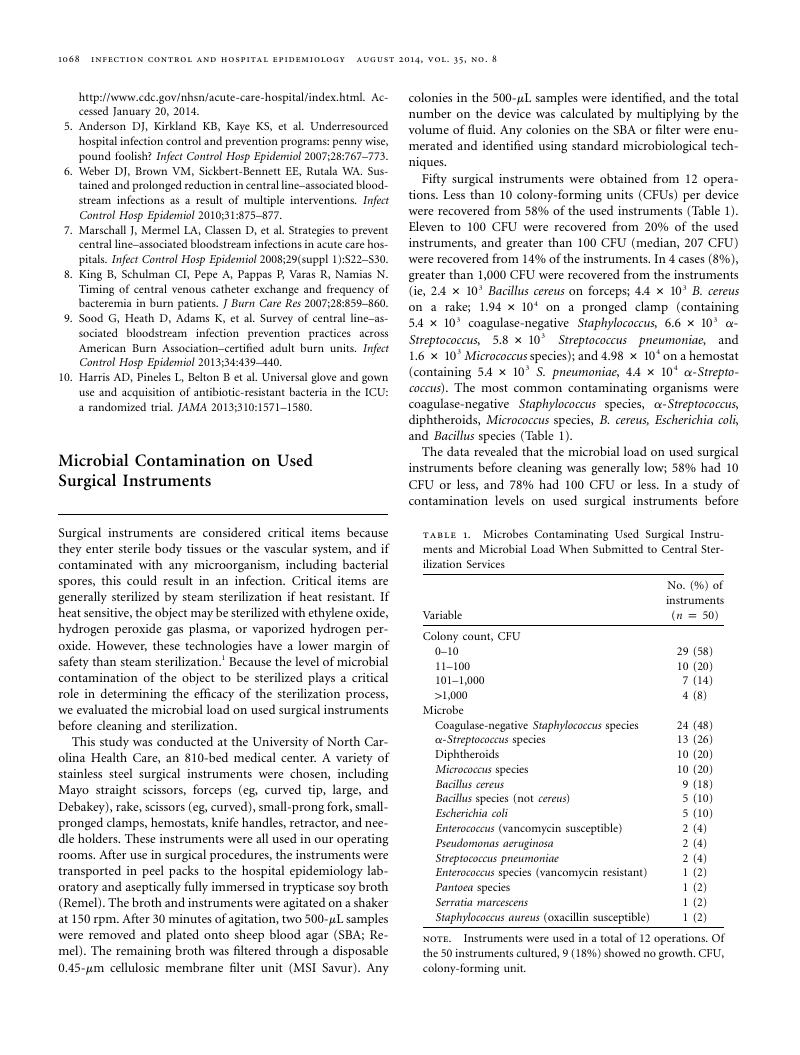Crossref Citations
This article has been cited by the following publications. This list is generated based on data provided by Crossref.
Rutala, William A.
and
Weber, David J.
2016.
Disinfection and Sterilization in Health Care Facilities.
Infectious Disease Clinics of North America,
Vol. 30,
Issue. 3,
p.
609.
Saito, Yuhei
Yasuhara, Hiroshi
Murakoshi, Satoshi
Komatsu, Takami
Fukatsu, Kazuhiko
and
Uetera, Yushi
2017.
Challenging Residual Contamination of Instruments for Robotic Surgery in Japan.
Infection Control & Hospital Epidemiology,
Vol. 38,
Issue. 2,
p.
143.
Badia, Josep M.
Rubio Pérez, Inés
Manuel, Alba
Membrilla, Estela
Ruiz-Tovar, Jaime
Muñoz-Casares, Cristóbal
Arias-Díaz, Javier
Jimeno, Jaime
Guirao, Xavier
and
Balibrea, José M.
2020.
Medidas de prevención de la infección de localización quirúrgica en cirugía general. Documento de posicionamiento de la Sección de Infección Quirúrgica de la Asociación Española de Cirujanos.
Cirugía Española,
Vol. 98,
Issue. 4,
p.
187.
Badia, Josep M.
Rubio Pérez, Inés
Manuel, Alba
Membrilla, Estela
Ruiz-Tovar, Jaime
Muñoz-Casares, Cristóbal
Arias-Díaz, Javier
Jimeno, Jaime
Guirao, Xavier
and
Balibrea, José M.
2020.
Surgical Site Infection Prevention Measures in General Surgery: Position Statement by the Surgical Infections Division of the Spanish Association of Surgery.
Cirugía Española (English Edition),
Vol. 98,
Issue. 4,
p.
187.
Weber, David J.
Rutala, William A.
Anderson, Deverick J.
and
Sickbert-Bennett, Emily E.
2023.
Biofilms on medical instruments and surfaces: Do they interfere with instrument reprocessing and surface disinfection.
American Journal of Infection Control,
Vol. 51,
Issue. 11,
p.
A114.
Rutala, William A.
and
Weber, David J.
2023.
Risk of disease transmission to patients from “contaminated” surgical instruments and immediate use steam sterilization.
American Journal of Infection Control,
Vol. 51,
Issue. 11,
p.
A72.
Nabi, Mansoor
ul Hussain, Mohd Isfaq
Qureshi, Sabia
Shanaz, Syed
Hussain, Syed Akram
Hussain, Ishraq
Bhat, Mohd. Altaf
Yatoo, Mohd. Iqbal
Kashoo, Zahid Amin
Hassan, Mir Nadeem
Badroo, Gulzar Ahmad
ul Tarfain, Najeeb
Udin, Faheem
and
Nabi, Nahida
2025.
Desiccation-assisted Fabrication: A Novel Method for Developing Antimicrobial Textiles in Clinical Settings Using Montmorillonite.
Journal of Pure and Applied Microbiology,
Vol. 19,
Issue. 1,
p.
498.



